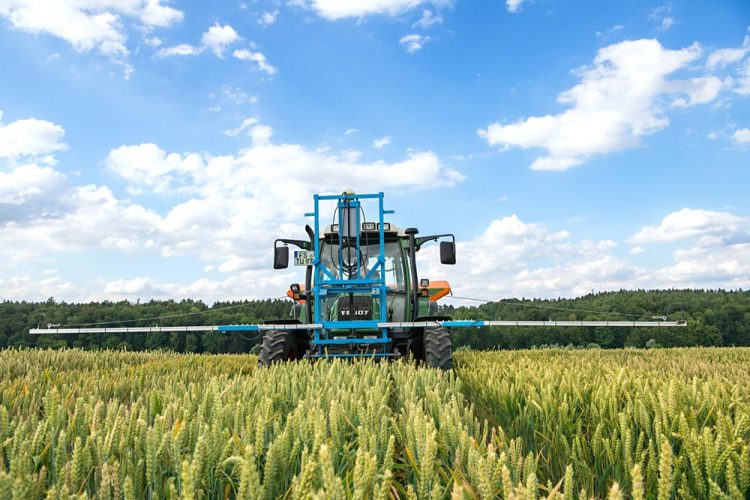Algorithms and sensors for sustainable and future-proof agriculture

One of the powerful tools for precision fertilization is a special multispectral sensor that can be attached to the tractor; pictured person: Josef Pruecklmaier, doctoral candidate at the Technical University of Munich. Copyright: Uli Benz / TUM
Up until now, farmers have calculated the amount of fertilizer per field on the basis of average yield and average soil quality. However, soil properties, yield potential and fertilizer needs may vary within limited areas, even within a single field.
In places that deviate from the field's mean, plants therefore receive too much or too little fertilizer. Excess nitrogen remains in the soil, accumulating over the years and eventually escaping into the environment, for example into the groundwater.
Professor Kurt-Jürgen Hülsbergen, chair of Organic Agriculture and Agronomy, is certain: “The fertilizer needs of crop plants will increasingly be calculated using sensor-based systems and fertilization algorithms.”
Precision fertilization using sensors and algorithms
Over the past two decades, Hülsbergen and his team have established a digital nutrient management system based on long-term field experiments. This system is used to analyse, evaluate and optimize the material and energy flows of agricultural production.
Research carried out by Hülsbergen's lab member Dr. Franz-Xaver Maidl usefully complements the opportunities afforded by precision fertilization. Maidl has developed a sensor-based system and algorithms for site-specific nitrogen fertilization.
Hülsbergen’s lab thus provides two digital instruments that help farmers save fertilizer and reduce the burden on the environment. A three-year research project starting now in January 2020 will subject these to extensive testing on a site located in Upper Bavaria (Burghausen / Burgkirchen) before making them available to agricultural practice and consultancy.
Web-based system for calculating optimal fertilizer needs
Hülsbergen's team has developed a modular, web-based management system that is now being tested on regional model sites such as Burghausen/Burgkirchen. This enables farmers not only to precisely determine the nutrient and fertilizer needs of their plants, but also to optimize fertilizer distribution under crop rotation.
The system can be used in both organic and conventional farming. The aim is to increase nitrogen efficiency and reduce environmentally relevant nitrogen emissions.
“A suitable fertilization algorithm ensures that farmers do not suffer any yield losses and that society benefits from high water quality,” explains Hülsbergen.
Sensors on the tractor process information from the crop directly
One of the powerful tools for precision fertilization is a special multispectral sensor that can be attached to the tractor. It measures the light reflected by the crop. The reflection can then be used to calculate the nitrogen nutritional status of the plants.
The system also takes account of the growth stage, soil quality and the desired product quality, and then calculates the optimum amount of fertiliser to be applied. This means that a single operation is enough to measure the current nitrogen content of the plant and to adjust the level of fertilizer applied in real time.
More information:
Professor Kurt-Jürgen Hülsbergen is a member of the World Agricultural Systems Center – Hans-Eisenmann-Forum (HEF) for Agricultural Sciences, an institute of the TUM. (http://www.hez.wzw.tum.de/index.php?id=3&L=1)
The studies reported here are sponsored by the Deutsche Bundesstiftung Umwelt DBU (German Federal Environmental Foundation), the Federal Office for Agriculture and Food (Bundesanstalt für Landwirtschaft und Ernährung) and the Bavarian State Ministry for Food, Agriculture and Forestry. There are several project partners involved across Germany.
The kick-off event for the project entitled “Reduction of nitrate discharges through digital nitrogen management and sensor-supported fertilization on the regional model site Burghausen/Burgkirchen (digisens)” will take place at the TUM Science & Study Center Raitenhaslach (https://www.raitenhaslach.tum.de/en/home/) on February 7, 2020. Further tests will follow in other German states (including Saxony, Brandenburg and North Rhine-Westphalia).
Contact:
Prof. Dr. Kurt-Jürgen Hülsbergen
Technical University of Munich
Chair of Organic Agriculture and Agronomy
sekretariat.oekolandbau@tum.de www.oekolandbau.wzw.tum.de
https://mediatum.ub.tum.de/1535241 (High Resolution Images for Journalists)
Media Contact
All latest news from the category: Agricultural and Forestry Science
Newest articles

NASA: Mystery of life’s handedness deepens
The mystery of why life uses molecules with specific orientations has deepened with a NASA-funded discovery that RNA — a key molecule thought to have potentially held the instructions for…

What are the effects of historic lithium mining on water quality?
Study reveals low levels of common contaminants but high levels of other elements in waters associated with an abandoned lithium mine. Lithium ore and mining waste from a historic lithium…

Quantum-inspired design boosts efficiency of heat-to-electricity conversion
Rice engineers take unconventional route to improving thermophotovoltaic systems. Researchers at Rice University have found a new way to improve a key element of thermophotovoltaic (TPV) systems, which convert heat…



